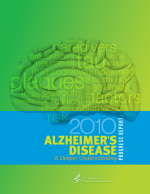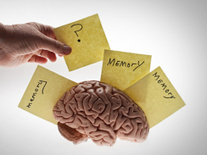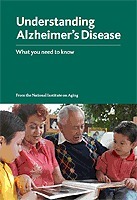Excerpted from the National Institute on Aging (NIA) Publication Frontotemporal Disorders, Information for Patients, Families, & Caregivers, 2012.
Few people have heard of frontotemporal dementia and other brain disorders that affect personality, behavior, language, and movement. These disorders are little known outside the circles of researchers, doctors, patients, and caregivers who study and live with them. Although frontotemporal disorders remain puzzling in many ways, researchers are finding new clues that will help them solve this medical mystery and better understand other common dementias.
The symptoms of frontotemporal disorders are devastating. They gradually rob people of basic abilities—thinking, talking, walking, and socializing—that most of us take for granted. They often strike people in the prime of life, when they are working and raising families. Families suffer, too, as they struggle to cope with the person’s daily needs as well as changes in relationships and finances.
The Basics of Frontotemporal Disorders
Frontotemporal disorders are the result of damage to neurons (nerve cells) in parts of the brain called the frontal and temporal lobes. As neurons die in the frontal and temporal regions, these lobes atrophy, or shrink. Gradually, this damage causes difficulties in thinking and behaviors controlled by these parts of the brain. Many possible symptoms can result, including strange behaviors, emotional problems, trouble communicating, or difficulty with walking and other basic movements.
A Form of Dementia
Frontotemporal disorders are a form of dementia caused by a family of brain diseases known as frontotemporal lobar degeneration (FTLD). Dementia is a severe loss of thinking abilities that interferes with a person’s ability to perform daily activities such as working, driving, and preparing meals. Other brain diseases that can cause dementia include Alzheimer’s disease and strokes. Scientists estimate that FTLD may cause up to 10 percent of all cases of dementia and may be about as common as Alzheimer’s among people younger than age 65.
People can live with frontotemporal disorders for 2 to 10 years, sometimes longer, but it is difficult to predict the time course for an individual patient. The disorders are progressive, meaning symptoms get worse over time. In the early stages, people have one type of symptom. As the disease progresses, other types of symptoms appear as more parts of the brain are affected.
No cure or treatments for frontotemporal disorders are available today. However, research is improving awareness and understanding of these challenging conditions. This progress is opening doors to better diagnosis, improved care, and, eventually, possible new treatments.
Changes in the Brain
Frontotemporal disorders affect the frontal and temporal lobes of the brain. They can begin in the frontal lobe, the temporal lobe, or both. Initially, frontotemporal disorders leave other brain regions untouched, including those that control short-term memory.
The frontal lobes, situated above the eyes and behind the forehead both on the right and left sides of the brain, direct executive functioning. This includes planning and sequencing (thinking through which steps come first, second, third, and so on), prioritizing (doing more important activities first and less important activities last), multitasking (shifting from one activity to another as needed), and monitoring and correcting errors.
When functioning well, the frontal lobes also help manage emotional responses. They enable people to control inappropriate social behaviors, such as shouting loudly in a library or at a funeral. They help people make decisions that make sense for a given situation.
When the frontal lobes are damaged, people may focus on insignificant details and ignore important aspects of a situation or engage in purposeless activities. The frontal lobes are also involved in language, particularly linking words to form sentences, and in motor functions, such as moving the arms, legs, and mouth.
The temporal lobes, located below and to the side of each frontal lobe on the right and left sides of the brain, play a major role in language and emotions. They help people understand words, speak, read, write, and connect words with their meanings. They allow people to recognize objects, including faces, and to relate appropriate emotions to objects and events. When temporal lobes are dysfunctional, people may have difficulty recognizing emotions and responding appropriately to them.
Which lobe—and part of the lobe—is affected first determines which symptoms appear first. For example, if the disease starts in the part of the frontal lobe responsible for decision-making, then the first symptom might be trouble managing finances. If it begins in the part of the temporal lobe that connects emotions to objects, then the first symptom might be an inability to recognize potentially dangerous objects—a person might reach for a snake or plunge a hand into boiling water, for example.
Types of Frontotemporal Disorders
Frontotemporal disorders can be grouped into three types, defined by the earliest symptoms physicians identify when they examine patients.
• Progressive behavior/personality decline—characterized by changes in personality, behavior, emotions, and judgment (e.g., behavioral variant frontotemporal dementia).
• Progressive language decline—marked by early changes in language ability, including speaking, understanding, reading, and writing (e.g., primary progressive aphasia).
• Progressive motor decline—characterized by various difficulties with physical movement, including shaking, difficulty walking, frequent falls, and poor coordination.
It can be hard to know which of these disorders a person has because symptoms and the order in which they appear can vary widely from one person to the next. Also, the same symptoms can appear in different disorders. For example, language problems are most typical of primary progressive aphasia but can also appear in the course of behavioral variant frontotemporal dementia.
Causes
Frontotemporal lobar degeneration (FTLD) is not a single brain disease but rather a family of brain diseases that share some common molecular features. Scientists are just beginning to understand the biological and genetic basis for the changes observed in brain cells that lead to FTLD.
Scientists describe FTLD in terms of physical changes in the brain seen in an autopsy after death. These changes include loss of neurons and abnormal amounts or forms of proteins called tau and TDP-43. These proteins occur naturally in the body and help cells function properly. When the proteins don’t work properly – for reasons not yet fully understood – neurons in the frontal and/or temporal lobes are damaged and disease results.
About 20 to 40 percent of people with frontotemporal disorders have a family history of them. About 10 percent of people inherit them directly from a parent. In most cases, the cause is unknown.
Treatment and Management
So far, there is no cure for frontotemporal disorders and no way to slow down or prevent them. However, there are ways to manage symptoms. A team of specialists—doctors, nurses, and speech, physical, and occupational therapists—familiar with these disorders can help guide treatment.
If you would like the full text of this publication, it is in the public domain and available at no cost at http://www.nia.nih.gov/alzheimers/publication/frontotemporal-disorders/introduction
If you would like to read this entire booklet and receive one hour of continuing education credit, visit Professional Development Resources at https://pdresources.org/course/index/6/1175/Frontotemporal-Disorders-Information-for-Patients-Families-and-Caregivers
More Free Resources:
- Acupuncture – An Introduction
- Attention Deficit Hyperactivity Disorder (ADHD)
- Herbs at a Glance
- Bipolar Disorder in Children and Adolescents
- The Challenge of Co-Parenting
- Adolescent Literacy
- Domestic Violence: Child Abuse and Intimate Partner Violence
- English Language Learning
- Helping Children Learn To Listen
- Ethics and Social Media
- Children’s Exposure to Violence





 Scientists say they “serendipitously” discovered that a drug used to treat a type of cancer quickly reversed Alzheimer’s disease in mice. “I want to say as loudly and clearly as possible that this was a study in mice, not in humans,” he said. “We’ve fixed Alzheimer’s in mice lots of times, so we need to move forward expeditiously but cautiously.”
Scientists say they “serendipitously” discovered that a drug used to treat a type of cancer quickly reversed Alzheimer’s disease in mice. “I want to say as loudly and clearly as possible that this was a study in mice, not in humans,” he said. “We’ve fixed Alzheimer’s in mice lots of times, so we need to move forward expeditiously but cautiously.” Alzheimer’s disease spreads through the brain by jumping from one cell to another, according to a new study.
Alzheimer’s disease spreads through the brain by jumping from one cell to another, according to a new study.
